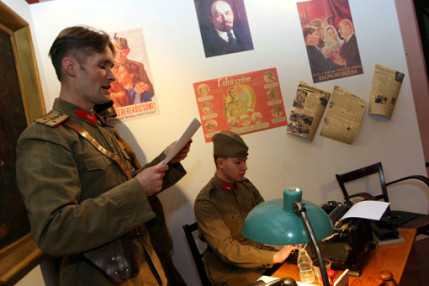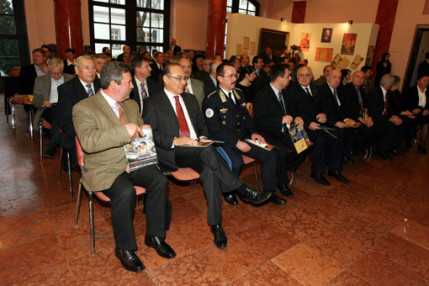”Tradition And Profession” – Magyar Honvéd Has Been Renewed
Szöveg: László Szűcs | 2009. január 31. 8:54Sixty-year-old Magyar Honvéd (Hungarian Soldier) magazine has arrived to another significant milestone in its history, since on Thursday, January 22, its public circulation has begun.
Those who visited the Marble Room of MoD Institute and Museum of Military History (HM HIM) in the Buda Castle in the afternoon of January 21, could witness a historical moment. For it was announced officially that Magyar Honvéd, the weekly journal of the Ministry of Defence has been renewed and is now available for everyone, in other words it can be subscribed to and also purchased at newsagents from January 22.

Of course, those who think that the Marble Room of HM HIM was only the site of a simple celebration are wrong, since an editorial room recalling the 1950s welcomed the invitees – the commanders of the corps, former and current journalists and photographers of the maganize. On the walls, there were photographs – among them the indispensable portrait of Lenin – and the proofs of the early issues of the journal Néphadsereg (People’s Army), and on the desk there was a seal and among other things, a traditional telephone which had to be cranked up first. In the editorial room a first lieutenant was dictating the leading article of Mihály Farkas, the minister of defence at the time to a sergeant sitting behind a Remington typewriter. The same leading article that was published in the first issue of the journal to leave the printing office on December 1, 1948. Perhaps we do not even have to say that the ’production’ of the ’tradition preservers’ dressed in uniforms of the period was a huge success… On the boards displayed in the room those who were interested could see the exhibition selected from the pictures of Magyar Honvéd’s former and current photographers.
At the event – which was also attended by Minister of Defence Imre Szekeres, General (Eng.) László Tömböl, Chief of the MoD Defence Staff, and Colonel (Ret.) Ferenc Hegedûs, a former member of the editorial staff and later the editor-in-chief of the journal Néphadsereg of 1948 – the participants could watch a film about the history of magazines Néphadsereg and Magyar Honvéd, then two artists of the Honvéd Ensemble, Ferenc Schmidt and Zoltán Molnár amused the representatives of the military press with a musical arrangement. They were also singing about Kerepesi Road for instance, where the office is located.
– In the Hungarian Defence Forces, the changes that have taken place in the last two decades have reached the military media as well. Military organizations dealing with cultural and media-related tasks were integrated into MoD Zrínyi Communications Public Non-Profit Company (HM Zrínyi Kommunikációs Kht.) that was founded eight years ago, in order that the non-profit company established this way could assist the internal and external communications, the implementation of media-related tasks with a considerably more modest employee number than the former organizations did, but with a professional management and preparation in accordance with the circumstances of our age, and concentrated powers – said István Orgovány, the Managing Director of HM Zrínyi Kht., the publisher of Magyar Honvéd.
He added: the past six decades of military press – and witin that, also the official journal of the Ministry of Defence – have been characterized by continuous change and renewal. Néphadsereg, published in 1948 for the first time, Magyar Honvéd, of which eleven issues were printed in the period of the 1956 revoution, Pont, aiming at a wider audience at the time of the change of the political system, and Célpont, which had also undertaken to implement internal communications tasks, Magyar Honvéd, re-launched in 1990, Ármádia, that is published with a more modern layout, and last but not least, the currently renewed Magyar Honvéd, which reaches the standard of prestigious civil magazines all tried to serve the same purpose – though in different periods, different political environments, and under different operational conditions: to provide a valid picture of the tasks, training, deployment, and internal life of the armed forces for the professional and the civil audience.
István Orgovány emphasized that as the managing director of HM Zrínyi Kht., the publisher of Magyar Honvéd magazine, he can confidently state that after the past decades of value creation, this journal, the history of which has such a solid reputation, will also meet the new challenges. Its duty is to provide information for the widest possible layers of society about the tasks of the military, the domestic and international commitments of the armed forces, internal life, and the expectations set for today’s soldiers, doing so in line with the communications strategy bearing in mind the special features of the voluntary armed forces.
– "Transformation and renewal", "tradition and profession" – key words that have been accompanying the past decades of our society, of the military, and the military media. In addition to continuous change and stability, adherence to professional values has also been a determining feature in the past sixty years in the daily life of those working, serving in the military media. I am convinced that carrying on the traditional values of the profession, and utilizing the info-communications achievements of the 21st century provide a stable basis for the staff of Magyar Honvéd magazine in implementing their sublime task in the next six decades as well – said István Orgovány.
Lieutenant General (Ret.) Dr. József Holló, General Director of MoD Institute and Museum of Military History recalled a few momentums of the history of Hungarian military press. He told the audience about dating the history of Hungarian periodical press from May 1705, when Mercurius Hungaricus was published. Ferenc Rákóczi II was the first Hungarian statesman to place a press product at the service of a large-scale national struggle. He deemed it was important that readers got realistic news – in Latin, of course – of the significant military and political events of the fight for freedom.
– “Tradition and profession" – we have emphasized at our events when we have been speaking highly of the various corps, organizations, institutions of the armed forces. I believe if we are talking about Magyar Honvéd magazine, the apropos of today’s celebratory event, it is proper to mention these words here as well. It is proper since Magyar Honvéd and its predecessors have been reporting in a professional way for six decades now on the everyday life of the military, and what is more, they have done so with utilizing the traditions of journalism and the military profession to the maximum extent – said Imre Szekeres in his speech, stressing that since the first issue of Néphadsereg was published, the actual defence ministers – as the founders of the magazine – have always considered the journal a key player in military communications. With a bit of exaggeration it could even be said if there is anything that is not covered by Magyar Honvéd, it could not have happened in the armed forces or in international military policy.

The defence minister emphasized: the history of the journal is inseparable from the endeavours of the founder, from the actual political and military guidelines. The magazine is a true reflection of the actual military.
– The editorial staff of Magyar Honvéd and that of its predecessors – in accordance with the aims of the journal founder – have been reporting sometimes as a daily paper, a weekly journal, or a monthly magazine, and on other occasions as the makers of either publicly or internally distributed journals on the daily life of those who have been serving the country, the nation. Military and civil journalists, photographers, editors, copy editors, proof-readers, desktop publishers, distributors, and many other people have been working for six decades now for high quality information provision, for the readers – said Imre Szekeres.
The defence minister added: last January, Magyar Honvéd made a change again. The readers get an excellently edited journal which is rich in pictures, readable, and is published monthly, naturally reflecting the daily life of the military that has new capabilities and is present in three continents, undertaking international service with one thousand troops.
– After having considered my colleagues’ recommendations, I have decided that as of this January, the weekly magazine Magyar Honvéd should be made available also at the newsagents and subscription should be open for civil readers as well. Thus Magyar Honvéd can forward information to the widest possible circle of readers about life in the military at home and abroad, the novelties of military technology, the security policy efforts of our allied system, and the remarkable days of Hungarian military history – emphasized Imre Szekeres.
The head of the defence portfolio has also mentioned that this day is remarkable not only because of the renewal of Magyar Honvéd, for the government of the Republic of Hungary accepted the national military strategy a mere hour ago.
Following the address of the minister, the management of HM Zrínyi Kht. awarded a Zrínyi ring to Colonel (Ret.) Ferenc Hegedûs, the former editor-in-chief of Néphadsereg for his outstanding career as a military journalist, his professional achievements, and continuing work and efforts to implement the tasks of the company; to Lieutenant Colonel (Ret.) Ferenc Gróf, the founding editor-in-chief of Magyar Honvéd launched in the spring of 1990, who had worked for the paper as the editor-in-chief until 1996, and later served the cause of national defence and military journalism at Zrínyi Kht. until 2007.
Béla Szabó, the journalist of Magyar Honvéd, Gabriella Kaszásné Bokor, the senior financial colleague of Zrínyi Kht., Kálmánné Kenderes, the editorial manager of Zrínyi Kht., and István Bocskai, the spokesman of the Ministry of Defence and head of the communications and recruitment department of the portfolio have also been awarded a Zrínyi ring.